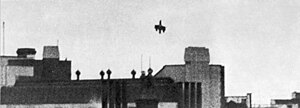
Back Battle of Britain Day French Hari Pertempuran Britania ID Battle of Britain Day Italian Hari Pertempuran Britain Malay Dia da Batalha de Inglaterra Portuguese День битвы за Британию Russian День битвы за Британию RUE Dan bitke za Anglijo Slovenian วันยุทธเวหาที่บริเตน Thai
| Battle of Britain Day | |||||||
|---|---|---|---|---|---|---|---|
| Part of the Battle of Britain | |||||||
 Dornier Do 17 of Kampfgeschwader 76 falling on Victoria Station, Sunday 15 September 1940 | |||||||
| |||||||
| Belligerents | |||||||
|
|
| ||||||
| Commanders and leaders | |||||||
|
|
| ||||||
| Units involved | |||||||
|
|
| ||||||
| Strength | |||||||
|
50,000 observers[3] 630 fighter aircraft[4] | 1,120 aircraft (620 fighters and 500 bombers)[4] | ||||||
| Casualties and losses | |||||||
|
29 aircraft destroyed[5] ~ 21 damaged[6] 14[7]–16 killed[5] 14 wounded[7] 1 captured[7] |
58 aircraft destroyed 20 severely damaged[8] 63[9]–81 killed[7] 63[7]–65 captured[9] 30[9]–31 wounded[7] 21 missing[9] | ||||||
Battle of Britain Day, 15 September 1940, is the day on which a large-scale aerial battle in the Battle of Britain took place.[8][10][11][12][13]
In June 1940, the Wehrmacht had conquered most of Western Europe and Scandinavia. At that time, the only major power standing in the way of a German-dominated Europe was the British Empire and the Commonwealth, given the non-aggression pact between Nazi Germany and the Soviet Union. After having several peace offers rejected by the British, Adolf Hitler ordered the Luftwaffe to destroy Britain's Royal Air Force (RAF) in order to gain air superiority or air supremacy as a prelude to launching Operation Sea Lion, an amphibious assault by the Wehrmacht onto the British mainland. In July 1940, the Luftwaffe started by closing the English Channel to merchant shipping. In August, Operation Adlerangriff (Eagle Attack) was launched against RAF airfields in southern England. By the first week of September, the Luftwaffe had not gained the results desired by Hitler. Frustrated, the Germans turned towards the strategic bombing of cities, an offensive which was aimed at damaging British military and civil industries, as well as civilian morale.
On Sunday 15 September 1940, the Luftwaffe launched its largest and most concentrated attack against London in the hope of drawing out the RAF into a battle of annihilation. Around 1,500 aircraft took part in the air battles which lasted until dusk.[4] The action was the climax of the Battle of Britain.[14] RAF Fighter Command defeated the German raids; the Luftwaffe formations were dispersed by a large cloud base and failed to inflict severe damage on the city of London. In the aftermath of the raid, Hitler postponed Sea Lion. Having been defeated in daylight, the Luftwaffe turned its attention to The Blitz night campaign which lasted until May 1941.[15]
Battle of Britain Day, 15 September, is now an annual commemoration of the battle in the United Kingdom. In Canada, the commemoration takes place on the third Sunday of September.
- ^ Murray 1983, pp. 52–54
- ^ Hough and Richards 2007, p. 283.
- ^ Collier 1980, p. 196.
- ^ a b c Bungay 2000, p. 319.
- ^ a b Terraine 1985, p. 211.
- ^ Price 1990, p. 106.
- ^ a b c d e f Bungay 2000, p. 333.
- ^ a b Overy 2001, p. 86.
- ^ a b c d Price 1990, pp. 154–163.
- ^ Bungay 2000, pp. 318, 334.
- ^ Mason 1969, p. 386.
- ^ Price 1990, p. 128.
- ^ Terraine 1985, p. 210.
- ^ Murray 1983, p. 52.
- ^ Murray 1983, p. 54.
© MMXXIII Rich X Search. We shall prevail. All rights reserved. Rich X Search